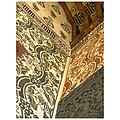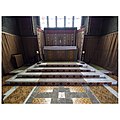All Saints' Church, Cambridge
| All Saints', Jesus Lane | |
|---|---|
 All Saints' Church from the south east | |
 Location in central Cambridge | |
| General information | |
| Architectural style | Gothic Revival |
| Location | Jesus Lane |
| Town or city | Cambridge, England |
| Country | United Kingdom |
| Coordinates | 52°12′30″N 0°07′24″E / 52.208277°N 0.123231°E / 52.208277; 0.123231Coordinates: 52°12′30″N 0°07′24″E / 52.208277°N 0.123231°E / 52.208277; 0.123231 |
| Construction started | 1863 |
| Completed | 1870 |
| Design and construction | |
| Architect | G. F. Bodley |
All Saints' is a church on Jesus Lane in central Cambridge, England, which was built by the architect George Frederick Bodley. The church was constructed in stages between 1863 and 1870 and is a notable example of English Gothic Revival style with fittings in the Arts and Crafts style. It was designated Grade I listed building[1] status in 1950. It was vested in The Churches Conservation Trust in 1981.
Contents
1 History
2 Architecture
3 Interior
4 See also
5 References
6 External links
History
A mediæval church, All Saints in the Jewry, stood in St John's Street, Cambridge. Its history dates back to the 11th century and by the 13th century was in the patronage of St Radegund's Nunnery, later re-established as Jesus College. The church was rebuilt several times but by the nineteenth century was deemed too small for the growing congregation. A new building was built in Jesus Lane, at its junction with Manor Road, and the old church was demolished in 1865. The churchyard of the original church is now an open space known as All Saints' Garden and contains a memorial cross designed by Basil Champneys in 1882.[2][3]
Although it was initially hoped that George Gilbert Scott would design the new church. G. F. Bodley who had been Scott's talented pupil (and was later a founder of Watts & Co.), was chosen. The foundation stone was laid on 27 May 1863 and was consecrated on 30 November 1864. Between 1869 and 1871 the present tower and spire were added, with St Oswald's Church, Ashbourne, Derbyshire, used as the model.[2]
By the early 1970s the congregation had reduced dramatically and regular services ceased in 1973. It lay redundant for several years and fell into disrepair, during which time plans to demolish part of the building arose. These were abandoned in 1981.[4] Today the church is used during term time by the neighbouring theological college, Westcott House, and is also available to hire for secular events, such as art exhibitions, concerts and talks. It is currently open weekdays for visitors.
Architecture
The church's spire is a prominent Cambridge landmark. At around 175 feet (53 m) in height it was, at its construction, the tallest building in the city; it remains the city's third tallest building, after the chimney of Addenbrooke's Hospital and Our Lady and the English Martyrs Church.[2] It is constructed from brick as well as Ancaster and Casterton stone with a nave, chancel and a south aisle. The vestry is at the east end of the south aisle.
Interior
The church is noted for its strikingly decorated interior, much of it to designs by Bodley. Fittings by Bodley include the alabaster font, the pulpit, south aisle screen, textiles, pews, candlesticks and tiles. The rood screen was designed in 1904 by John Morley, architect at Rattee & Kett of Cambridge. Its function was not purely liturgical as its cornice hid a large support beam which had been added to bolster the chancel arch from the massive weight of the spire.
The wall and ceiling decorations were applied by F. R. Leach & Sons and form complex, bold stencilled patterns throughout the church. As well as exotic floral friezes there is much use of religious symbolism such as the Sacred Monogram and the Fleur-de-lis. Around the upper walls are texts from the Book of Revelation (Revelation 7:9) and Psalms in the south aisle, and the Beatitudes (Matthew 5:3-12) in the nave. Part of the Beatitudes have been lost due to water damage to the plaster.[2] One of the team of artists was David Parr who is known to have decorated his own house in similar style/designs. His residence is currently being restored and is due to open to the public in 2019.
The east window was designed by Edward Burne-Jones and executed by Morris & Co. It was installed in 1866 as a memorial to Lady Affleck, wife of William Whewell, master of Trinity College, Cambridge. She had lain the foundation stone of the church in 1863 and also donated £1,000 to its construction. The twenty figures, over four rows, were individually designed by Burne-Jones (12 panes), Ford Madox Brown (4 panes) and William Morris (4 panes). The diagonal lettering and oak leaf borders were designed by Philip Webb. It is most notable for its high proportion of pale, silver-tint glass, which is believed to be a rebellion against the dark, rich colours prevalent in stained glass of the time. In the north aisle are three windows by Charles Eamer Kempe and one by Douglas Strachan installed in 1944 which features depictions of Elizabeth Fry, Josephine Butler, Edith Cavell and Mother Cecile Isherwood.

All Saints' Church from the eastern end of Jesus Lane

Nave, arcade and south aisle

Chancel arch with painting of "Christ in Majesty" by Wyndham Hope Hughes

Bodley's designs in the SE corner of the south aisle

The altar

South aisle, looking east

Judas Maccabeus by Edward Burne-Jones from the east window by Morris, Marshall, Faulkner & Co.

The 'Womanhood' window by Douglas Strachan in the NW nave

George Bodley, architect of All Saints'

Nave stencilling by F. R. Leach & Sons

Forster & Andrews organ of 1864

South aisle
See also
- English Gothic architecture
- British and Irish stained glass (1811–1918)
- Arts and Crafts movement
- Anglo-Catholicism
References
^ Historic England. "All Saints Church (Grade I) (1126204)". National Heritage List for England. Retrieved 19 January 2015..mw-parser-output cite.citation{font-style:inherit}.mw-parser-output q{quotes:"""""""'""'"}.mw-parser-output code.cs1-code{color:inherit;background:inherit;border:inherit;padding:inherit}.mw-parser-output .cs1-lock-free a{background:url("//upload.wikimedia.org/wikipedia/commons/thumb/6/65/Lock-green.svg/9px-Lock-green.svg.png")no-repeat;background-position:right .1em center}.mw-parser-output .cs1-lock-limited a,.mw-parser-output .cs1-lock-registration a{background:url("//upload.wikimedia.org/wikipedia/commons/thumb/d/d6/Lock-gray-alt-2.svg/9px-Lock-gray-alt-2.svg.png")no-repeat;background-position:right .1em center}.mw-parser-output .cs1-lock-subscription a{background:url("//upload.wikimedia.org/wikipedia/commons/thumb/a/aa/Lock-red-alt-2.svg/9px-Lock-red-alt-2.svg.png")no-repeat;background-position:right .1em center}.mw-parser-output .cs1-subscription,.mw-parser-output .cs1-registration{color:#555}.mw-parser-output .cs1-subscription span,.mw-parser-output .cs1-registration span{border-bottom:1px dotted;cursor:help}.mw-parser-output .cs1-hidden-error{display:none;font-size:100%}.mw-parser-output .cs1-visible-error{font-size:100%}.mw-parser-output .cs1-subscription,.mw-parser-output .cs1-registration,.mw-parser-output .cs1-format{font-size:95%}.mw-parser-output .cs1-kern-left,.mw-parser-output .cs1-kern-wl-left{padding-left:0.2em}.mw-parser-output .cs1-kern-right,.mw-parser-output .cs1-kern-wl-right{padding-right:0.2em}
^ abcd
"All Saints' Church, Cambridge, Cambridgeshire". Churches Conservation Trust. Retrieved 25 March 2011.
^
Ian Kitching. "Religious & Hospital Foundations". Cambridge — Past, Present and Future. Retrieved 2008-05-31.
^ Cambridge Association of Architects. "Rebranding Cambridge" (PDF). Cambridge Architecture Gazette. Archived from the original (PDF) on 2011-06-08. Retrieved 2008-05-31.
External links
| Wikimedia Commons has media related to All Saints, Cambridge. |
All Saints' Church, Cambridge - Churches Conservation Trust website
All Saints - Westcott House website
David Parr House - David Parr House website











